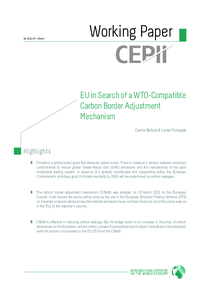EU in search of a WTO-compatible carbon border adjustment mechanism

Centre d'études prospectives et d'informations internationales, Paris
CEPII - Paris
2020
43 p.
decarbonization ; trade union ; climate change
Working Paper
2022-01
Trade
http://www.cepii.fr/CEPII/fr/publications/wp/abstract.asp?NoDoc=13289
English
Bibliogr.
"To meet the targets of the EU's ”Fit for 55” package, the European Commission proposes to implement a Carbon Border Adjustment Mechanism (CBAM). The CBAM is firstly intended to avoid carbon leakages, but it also deals with the thorny issue of the compliance by European producers in carbon-intensive industries. In addition, its design, as voted by the European Council on March 15, 2022, questions the compatibility of the CBAM with World Trade Organization (WTO) rules. The CBAM puts a price on carbon contained in imported products whose production-related emissions have not been taxed (or not at the same level as in the European Union) by the exporter country, in order to offset the difference in carbon prices at the border. This paper aims to quantify the economic and environmental impacts of different CBAM design choices with the aim of complying with WTO rules. Different from the previous literature, we evaluate the various options with a dynamic general equilibrium model featuring imperfect competition, global value chains, green-house gas emissions and endogenous price of emission quotas. We show that CBAM is effective in reducing carbon leakages. But its design leads to an increase in the price of carbon quotas in the European Emission Trading System (ETS) market. Losses in competitiveness on export markets are expected, also for downstream sectors not covered by the EU ETS nor the CBAM. Eventually, offsetting the difference in carbon prices at the border comes at a cost to the enforcing jurisdiction, suggesting that the CBAM was not designed as a beggar-thy-neighbour policy."
Digital
The ETUI is co-funded by the European Union. Views and opinions expressed are however those of the author(s) only and do not necessarily reflect those of the European Union or the ETUI.